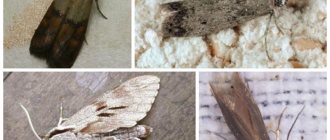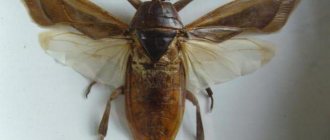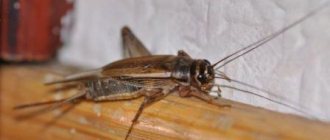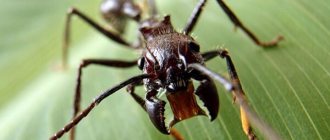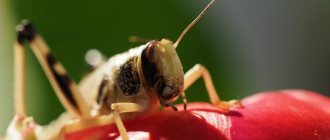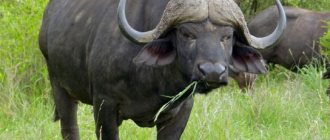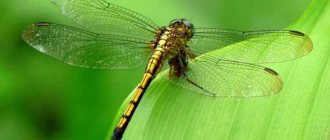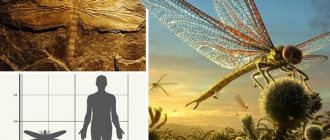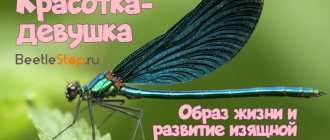Adult representatives of the species live on land, being specialized predators, they absorb an incredible number of flying insects. Dragonfly larvae feed primarily on waterfowl invertebrates or juveniles. The main benefit of these insects for humans is to regulate the number of mosquitoes and crop pests.
general information
Kazara
Dragonfly larvae (kazara)
painted in brown-olive tones. Dragonfly eggs are laid in water or in the tissue of aquatic plants. The eggs hatch into larvae of an extremely characteristic shape, interesting in their biological characteristics. These larvae play an important role among other living material of freshwater excursions.
Dragonfly larvae are found everywhere in standing and slowly flowing water. Most often they are found on aquatic plants or on the bottom, where they sit motionless, sometimes moving slowly. There are species that burrow into mud. All larvae can be divided into three groups:
- Larvae of the rocker dragonfly type (Aeschna
) with an elongated body and a flat mask. This includes the largest species that are similar to each other. In the northern regions there are representatives of the genera: Gomphus - grandfather, Onychogomphus, Gordulegaster, etc. - Larvae of the common or true dragonfly (Libellula) type
with a shorter and wider body than the previous ones. The mask is helmet-shaped. They stay mainly at the bottom, often in a layer of silt. The following genera are typical for the northern regions: Libellula - true dragonfly, Cordulla - grandma, Leucorrhinia, Epitheca (Fig. 206), Sympetrum, etc. - Larvae of the lute type (Agrion)
with a very long elongated body, which has leaf-shaped gill plates at the rear end. We have representatives of the genera: Agrion - arrows, Lestes - lyutki, Erythromma (Fig. 207), Calopteryx - beauties, etc.
Nutrition
Dragonflies feed on a wide variety of insects. Their diet also includes blood-sucking animals: midges, mosquitoes, horseflies. The body shape of these creatures, which helps them fly beautifully, also provides them with significant service during hunting.
Dragonflies tend to attack their victims from below, overtaking them in the air. There is an explanation for this, because against the background of the sky, the visual organs of these predators, which actively react to ultraviolet and blue colors, are able to perceive objects best.
Data are naturally endowed with a powerful mouth and serrated jaws, which helps them deal with prey. And its capture is facilitated by special claws, hard hairs on the legs and short antennae.
Dragonflies can eat weak members of their species
In an effort to get food for itself, the dragonfly
capable of engaging in single combat with an opponent larger than her. These creatures are very voracious, which brings considerable benefit by exterminating mosquitoes, flies and harmful insects.
They start hunting at dawn, and as soon as the sun sets, they settle down to sleep on the leaves of plants.
Description
When we are near bodies of water in the summer, we are all accustomed to seeing colorful dragonflies scurrying back and forth. This shy insect, which is almost impossible to catch with your hands, is often prey for fish that hunt in the surface layer of water. A dragonfly's habit of landing on twigs or lily pads that have fallen into the water, or simply a desire to fly too close to the surface, can be fatal. Bleak, chub, trout - all these fish are not averse to eating dragonflies. But few people know that much more often the victim of hungry fish is not the dragonfly itself, but its larva.
The larvae of each dragonfly species have their own unique shape. Frankly speaking, their appearance is not particularly pleasing to our eyes with beauty. Some of the dragonflies have creepy-looking nymphs - this is the scientific name for the larval stage of insect development. Traditionally, dragonfly larvae live and develop in reservoirs or parts of reservoirs with standing water, often silted, overgrown with aquatic vegetation, or swampy. Moreover, they easily survive both in completely fresh water bodies and in brackish ones. Depending on the species, nymphs can live burrowing deep into the muddy bottom, or move in the mud near the surface, or along the bottom itself, crawling along it with enviable leisureliness. Many species also live in thickets of aquatic vegetation, where it is easier for them to hide from external enemies. Depending on the habitat, the color of the nymphs varies - from yellow to almost black.
What does a dragonfly eat?
The very structure of these insects indicates that they are predators. With the help of additional eyes, a flying dragonfly notices prey within a radius of 8 meters, and its powerful jaws are capable of chewing even a hard chitinous shell. These insects are considered beneficial
because they destroy pests.
They catch large prey with their tenacious paws, and grab small prey on the fly with their mouth. Mosquitoes and midges are eaten by hunters in the air, but in order to eat larger prey they have to descend to the ground. Holding the prey with its paws, the dragonfly dismembers it and devours it.
The hunting of dragonflies is fascinating. They dive, maneuver their wings, and zigzag. Even nimble flies cannot escape pursuit. Like many insect predators, dragonflies are very voracious and eat several times their own weight in prey per day. For example, the predator eats up to forty flies a day.
These insects prefer to hunt near water
, there is always enough prey here to satisfy oneself. In addition, bodies of water provide an environment where dragonflies lay their eggs. This means that they can reproduce and feed in one place, which is quite convenient.
What do dragonflies do at night? Are they flying or sleeping? The answer to this question depends on the species. Eyewitnesses claim to have seen these insects flying in the night sky over the Indian Ocean. Species living in Russia descend for the night after sunset and sleep until dawn, and with the first rays of the sun they go hunting again.
Dragonfly's roost
found in the open air. They cling tightly with all their paws to tall blades of grass or branches of bushes and fall asleep. By the way, these insects behave the same way in rainy weather. They fly only during hot sunny hours.
Method of obtaining larvae
For prey, geese use a kind of “mormyshnitsa”. The device is a metal tube with a diameter of 15-20 cm and a length of 20-30 cm, one side of it is tightly welded and a mount for a wooden handle (like a shovel) is welded to it. The other side is cut slightly at an angle to the length, and holes with a diameter of about 1 cm are drilled in rows in the walls of the tube.
Dragonfly larvae are dug for fishing 1-3 days in advance. To do this, they look for banks with steep muddy ravine. The jig is stuck into such a bank, at a depth of 0.3-1 m under water, and then, filled with silt, it is raised to the surface. And at the water's edge, they pick out the silt with their hands, pouring water on it. In the silt, you can’t even see the larva, but when doused with water, it begins to flutter and is quickly transferred to a jar of water.
Structure
The dragonfly, the structure of which we are considering in this material, has a long and very thin body. It, in turn, is connected to the cephalothorax. On the dragonfly's body we can see three pairs of legs and two pairs of wings
It is also important to note that the wings are transparent; they can have the same size and shape, or different. We will talk about this in more detail when we consider the types
The dragonfly, whose structure can vary by species, can belong to one of two main groups:
- Homoptera.
- Varioptera.
As you might guess, the first group includes individuals that have wings of equal length and shape, while others have the opposite (one pair can be very different from the other). On the dragonfly's head we can clearly distinguish large eyes and antennae. A little more about the senses. The eyes of these insects are complex. They can be divided into two sections:
- the top one, responsible for object recognition;
- the lower one, responsible for color recognition.
You've probably noticed that the transparent wings of dragonflies have veins along their entire length, and at their tips there are spots darker than the color of the wings themselves. This device helps avoid wing fractures by reducing vibration during flights.
Remember how flight occurs in other flying creatures. This is a beautiful and synchronized movement of the wings. Dragonflies have distinguished themselves here too; the movements of their wings can be asynchronous when they are balancing, but synchronous to increase speed
It is also important to know that these nimble creatures can reach flight speeds of up to 50 kilometers per hour.
Fishing with kazara
The most promising time for using goosefish as bait is from the beginning of June to the end of September. When fishing with a float rod, anglers who fish with maggots have a significantly larger catch than anglers who fish with dung worms or maggots.
When placing this bait on a hook, the hook tip is threaded through the body, starting from the head of the larva. You can start planting from the head. As you prefer. It is advisable to place several small larvae on one hook.
The larvae are great for catching ide, fairly large perch, silver bream, chub and many other fish.


